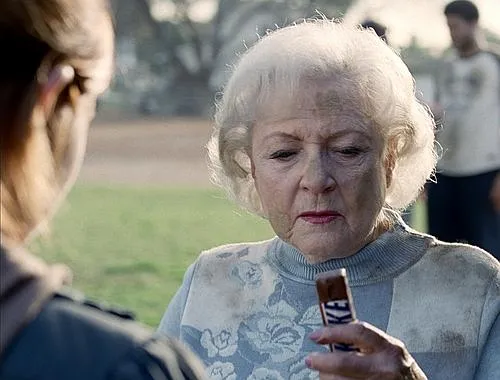Why do jokes travel faster than logos? We’ve all seen ads where the joke lands, but the brand doesn’t. The gag gets repeated in offices, group chats, and playgrounds — but when people are asked who the ad was for, silence follows.
This is the paradox of humour in advertising: it creates lightning-fast attention and emotional spikes, but unless the brand runs alongside the laugh, the memory trace belongs to the punchline, not the product.
Mastering Humour: A Snickers Example
At Super Bowl XLIV in 2010, Snickers found the recipe to make people laugh while keeping its brand front and centre.
The ad unfolds as follows: A football player takes a hit and suddenly turns into Betty White. The crowd roars. The spot that launched Snickers’ You’re Not You When You’re Hungry campaign didn’t separate the brand from the joke — it made the brand the joke itself. Betty White wasn’t herself because she was hungry, and a Snickers bar fixed it. The laugh and the logo landed together.
Thus, this memorable scene launched the ‘You’re Not You When You’re Hungry’ campaign, which became a massive success worldwide.
This concept worked because the brand was at the heart of the joke. The strength of the idea lies in the fact that the joke and the product are one and the same.
👉 Want to achieve the same level of success? Discover how Cube AI can help you create ads that hit the mark every time.
The Science Behind the Smile
-
- Humour hijacks attention. Anticipating a punchline primes the brain, creating measurable spikes in focus and positive emotion.
-
- But memory locks quickly. If the brand doesn’t appear until after the laugh, the joke is what gets encoded, leaving the logo as an afterthought.
-
- What the research shows. Humour enhances recall when paired with strong brand cues.
- Oracle research found 90% of consumers recall a brand linked with humour more easily, and 72% prefer a humorous brand over competitors.
- Neuroscience studies also confirm that early exposure to brand assets — logos, slogans, or distinctive cues — increases recognition and memory.
- What the research shows. Humour enhances recall when paired with strong brand cues.
Essentially, Snickers avoided the pitfall by merging humour with brand identity.
-
- The setup—Betty White on the field—representing hunger;
- The payoff—eat a Snickers, return to yourself—representing the brand.
The Trap Most 30-Second Spots Fall Into
Many advertisers still save their gag for the 15-second mark and only reveal the brand at second 27. By then, attention has dipped, the laugh has already been stored, and the memory belongs to the joke — not the advertiser.
It’s the advertising equivalent of hosting a dinner party, delivering a great punchline, and then introducing yourself as everyone is walking out the door.
The Impact of Getting It Right
Snickers didn’t just entertain; it sold. In the campaign’s first year, global sales rose 15.9%, and market share increased in 56 out of 58 markets where it aired. By making the brand the punchline, Snickers ensured the joke carried the product along with it.
The Marketing Lesson
Humour is a vehicle, not a destination. It moves faster than logos, faster than rational copy, faster than offers. But when the brand is woven directly into the joke, the laugh becomes a branded memory trace.
If your audience laughs but can’t name you afterward, you’ve just bought airtime for someone else. If the brand is the laugh — as Snickers showed — you’ve bought both attention and sales.
👉 Want your ads to make people laugh and sell? Discover how Cube AI can help you create unforgettable campaigns.




